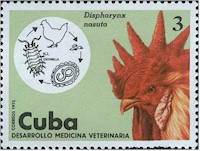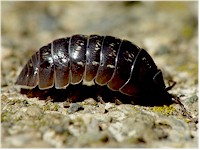Acuaria is a genus of parasitic roundworms that infects numerous domestic birds (chickens, turkeys, pigeons, guinea fowls, etc.). These worms are not as frequent as other gastrointestinal roundworms of poultry (e.g. Ascaridia spp, Capillaria spp, Heterakis spp), but prevalence can be as high as 50%.
that infects numerous domestic birds (chickens, turkeys, pigeons, guinea fowls, etc.). These worms are not as frequent as other gastrointestinal roundworms of poultry (e.g. Ascaridia spp, Capillaria spp, Heterakis spp), but prevalence can be as high as 50%.
These worms do not affect dogs, cats, cattle sheep, goats, horses or swine.
The most relevant species for poultry are:
- Acuaria spiralis = Dispharynx spiralis = Dispharynx nasuta = Synhimantus nasuta, found mainly in America, Africa and Asia.
- Acuaria hamulosa = Cheilospirura hamulosa, known also as the gizzard worm, found mainly in Africa (up to 50% prevalence), but reported also in America and Asia.
The disease caused by Acuaria worms is called acuariasis, acuariosis, synhimantiasis, etc
Are birds infected with Acuaria worms contagious for humans?
- NO: The reason is that these worms are not human parasites.
You can find additional information in this site on the general biology ofparasitic worms and/or roundworms.
Final location of Acuaria worms
Predilection site depends on the species:
- Acuaria spiralis = Dispharynx spiralis = Dispharynx nasuta = Synhimantus nasuta: proventriculus or true stomach and esophagus, seldom in the small intestine.
- Acuaria hamulosa = Cheilospirura hamulosa: gizzard
Anatomy of Acuaria worms
Adult Acuaria spiralis are up 10 mm long, those of Acuaria hamulosa up to 25 mm. Females are longer than males.
As in other roundworms, the body of these worms is covered with a cuticle, which is flexible but rather tough. Chacateristic for these worms are four long cuticular cordons in the anterior end. The body of Acuaria spiralis is usually rolled in a spiral. Males of both species have tail flaps (alae) and papillae. The worms have a tubular digestive system with two openings. They also have a nervous system but no excretory organs and no circulatory system, i.e. neither a heart nor blood vessels.
Each male has a rudimentary bursa with two unequally long spicules for attaching to the female during copulation. In Acuaria spiralis one of the spicules is much longer than the other one, whereas in Acuaria hamulosa one spicule is only slightly longer than the other one.
The eggs of both species are oval, embryonated and with a thick shell. Those of Acuaria spiralis are ~20x30 micrometers, those of Acuaria hamulosa ~26x42 micrometers.
Life cycle of Acuaria worms

These Acuaria species have indirect life cycles. Intermediate hosts are terrestrial crustaceans (isopods) such as e.g. pill bugs, sow bugs for Acuaria spiralis, and grasshoppers and beetles for Acuaria hamulosa.
Adult female worms lay embryonated eggs in the host's gut that are passed with the feces. Intermediate hosts ingest the eggs, which develop to infective L3-larvae in 3 to 8 weeks, depending on the worm species and the host.
Birds become infected after eating contaminated bugs, grasshoppers or other intermediate hosts. Larvae are released after digestion and rich the predilection organ rather quickly, where they complete development to adult worms and start to produce eggs.
The prepatent period (time between infection and first eggs shed) is about 3 weeks for Acuaria hamulosa.
Harm caused by Acuaria worms, symptoms and diagnosis
Light infections are mostly non-pathogenic, but heavy ones, especially with Acuaria spiralis can be severely harmful, particularly for young birds. They can burrow deeply in the lining of the affected organs and cause the development of nodules that can strongly hamper swallowing and damage the lining (ulcers, inflammation, thickening, etc.). Atrophy of the crop and proventriculus muscles with loss of elasticity can also occur. Predominant clinical signs are weakness, anemia, loss of appetite and weight, and reduced egg production in layers.
These worms are more likely to infect birds kept outdoors under traditional farming conditions, because they are more likely to eat contaminated bugs, grasshoppers or other intermediate hosts, especially in areas with humid soils or aquatic environments.
Diagnosis is based on detection of typical eggs in the feces and/or on identification of the worms in their predilection sites after necropsy.
Prevention and control of Acuaria infections
To prevent or at least reduce Acuaria infections it is recommended to keep the birds' bedding as dry as possible and to frequently change it, because survival of the worms' eggs needs humidity. For birds kept outdoors in endemic regions it is advisable to restrict their access to dark and humid environments where intermediate hosts are usually more abundant. All these measures are especially important for young birds, which are likely to suffer more from Acuaria infections.
The use of insecticides to kill the intermediate hosts is not advisable. It is virtually impossible to eliminate all the potential intermediate hosts with insecticides. And it would be highly detrimental for the environment, because it would kill not only the intermediate hosts, but numerous beneficial insects and other invertebrates as well.
Numerous classic broad spectrum anthelmintics are effective against Acuaria worms, e.g. several benzimidazoles (albendazole, fenbendazole, flubendazole, mebendazole, oxfendazole, etc.), levamisole, as well as macrocyclic lactones (e.g. ivermectin). Some compounds with a narrower spectrum are also effective against these worms, e.g. piperazine derivatives and pyrantel.
For use on poultry these active ingredients are usually available as additives for feed or drinking water, seldom as injectables or tablets (mainly for single animal treatment, typical for fighting roosters). However, in some countries Acuaria species may not be included in the label of most wormers, because they are less frequent.
Most such wormers (e.g. benzimidazoles, levamisole, piperazine derivatives and pyrantel) kill the worms shortly after treatment and are quickly metabolized and/or excreted within a few hours or days. This means that they have a short residual effect, or no residual effect at all. As a consequence treated animals are cured from worms but do not remain protected against new infections. To ensure that they remain worm-free the animals have to be dewormed periodically, depending on the local epidemiological, ecological and climatic conditions.
So far no vaccine is available against Acuaria worms. To learn more about vaccines against parasites of livestock and pets click here.
Biological control of Acuaria worms (i.e. using its natural enemies) is so far not feasible.
You may be interested in an article in this site on medicinal plants against external and internal parasites.
Resistance of Acuaria worms to anthelmintics
There are a no reports on confirmed resistance of Acuaria worms to anthelmintics.
This means that if an anthelmintic fails to achieve the expected efficacy against Acuaria worms it is most likely that either the product was unsuited for the control of these worms, or it was used incorrectly.
|
Ask your veterinary doctor! If available, follow more specific national or regional recommendations for Acuaria control. |